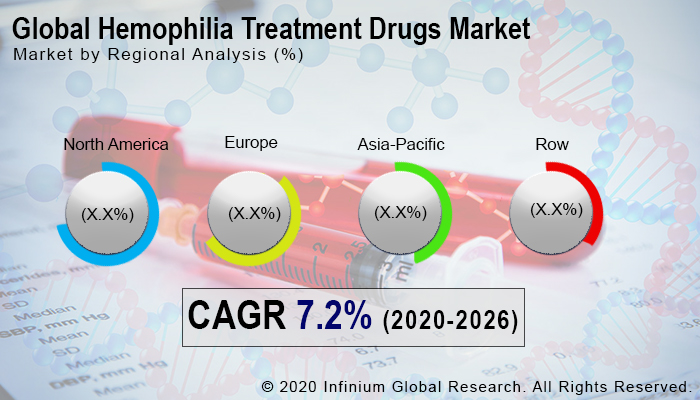Hemophilia Treatment Drugs Market (Drug Class - Desmopressin, Antifibrinolytic Agents, Recombinant Coagulation Factor Concentrates, Plasma Derived Coagulation Factor Concentrates, and Fibrin Sealants; Disease Indication - Hemophilia A, Hemophilia B, and Others; Distribution Channel - E-commerce, Retail Pharmacies, and Hospital Pharmacies): Global Industry Analysis, Trends, Size, Share and Forecasts to 2026
A recent report published by Infinium Global Research on the hemophilia treatment drugs market provides an in-depth analysis of segments and
sub-segments in the global as well as regional hemophilia treatment drugs
market. The study also highlights the impact of drivers, restraints, and macro
indicators on the global and regional hemophilia treatment drugs market over
the short term as well as long term. The report is a comprehensive presentation
of trends, forecast, and dollar values of the global hemophilia treatment drugs
market. According to the report, the global hemophilia treatment drugs market
is projected to grow at a CAGR of 7.2% over the forecast period of 2020-2026.
Market Insight
Hemophilia is defined as a hereditary genetic disorder that
damages the body’s ability to control blood clotting or coagulation. This leads
to abnormal external and internal bleeding after injuries. The most common
hemophilia seen in patients are hemophilia A and B. Hemophilia A arises when
clotting factor VIII is reduced while hemophilia B arises when clotting factor
IX is decreased. Even if both hemophilia is having similar symptoms and signs
they are caused by mutations in diverse genes. Both A and B hemophilia can be
mild, moderate, or severe, which depends on the amount of clotting factor that
is in the blood. As per the Center for Disease Control and Prevention,
Hemophilia A affects 1 in 5,000 male births and about 400 babies are born with
hemophilia each year.
Increasing awareness regarding hemophilia is driving
the growth of the hemophilia treatment drugs market. Government and
organizations along with manufacturers of hemophilia drugs are concentrating on
worldwide campaigns to generate consciousness regarding hemophilia among the
population that is anticipated to upsurge the diagnosis rate for hemophilia.
Further, with the support of the World Federation of Hemophilia (WFH) and
domestic policies, hemophilia care in emerging countries is developing
gradually. Additionally, several companies in the hemophilia treatment drugs
market are collaborating with each other and along with research, organizations
are developing new drugs in order to treat current and future unmet hemophilia
conditions. Moreover, the life expectancy of people with hemophilia has also
grown due to the advancements in medical science and the growing availability
of safer treatment options. In the 1900s, patient life expectancy was only
about 13 years whereas, by the 1960’s it had improved to about age 20.2, and
today, a baby born with hemophilia in one of the advanced economies can expect
to live a normal lifespan with the advanced treatment. This increasing life
expectancy for hemophiliacs coupled with the lifelong nature of the disease
will drive the growth of the hemophilia treatment drug market over the forecast
period. Advancement in technology and the growth of novel coagulating factors
are also some of the supporting factors for the growth of the hemophilia treatment
drugs market. Moreover, advancement in gene therapy and drugs approved for
treatment in hemophilia is likely to create growth opportunities in this market
during the upcoming year. On the flip side, lack of awareness regarding these
diseases in developing the region and the high cost associated with the
treatment are hampering the growth of the market.
In terms of geographies, North America dominated the
growth of the hemophilia treatment drugs market followed by Europe and the Asia
Pacific region. In North America region technological advancement, rising
occurrence of hemophilia diseases, increasing investment in R&D activities
for development in hemophilia drugs, and the growing practice of the
recombinant product drivers the growth of this market. In the Europe region
growing government support, rising occurrence of hemophilia A and upsurge in
investment in innovation of new hemophilia products are positively supporting
the growth of the hemophilia treatment drugs market. Further, in the Asia Pacific
region due to increasing awareness about hemophilia diseases, development in
healthcare sectors, increasing spending on healthcare and growing population
are boosting factors for this market in the Asia Pacific region.

Segment Covered
The report on global hemophilia treatment drugs market
covers segments such as drug class, disease indication, and distribution
channel. On the basis of drug class, the sub-markets include desmopressin,
antifibrinolytic agents, recombinant coagulation factor concentrates, plasma
derived coagulation factor concentrates, and fibrin sealents. On the basis of
disease indication, the sub-markets include hemophilia A, hemophilia B, and
others. On the basis of distribution channel, the sub-markets include
e-commerce, retail pharmacies, and hospital pharmacies.
Companies Profiled:
The report provides profiles of the companies in the market
such as Takeda Pharmaceutical Company Ltd, Biotest Aktiengesellschaft, Sanofi
S.A., Bayer AG, Pfizer Inc., CSL Limited, Octapharma AG, F. Hoffmann-La Roche
AG, Novo Nordisk A/S, and Kedrion S.p.A.
Report Highlights:
The report provides deep insights into the demand forecasts,
market trends, and micro and macro indicators. In addition, this report
provides insights into the factors that are driving and restraining the growth
in this market. Moreover, The IGR-Growth Matrix analysis given in the report
brings an insight into the investment areas that existing or new market players
can consider. The report provides insights into the market using analytical
tools such as Porter's five forces analysis and DRO analysis of hemophilia
treatment drugs market. Moreover, the study highlights current market trends
and provides forecast from 2020-2026. We also have highlighted future trends in
the market that will affect the demand during the forecast period. Moreover,
the competitive analysis given in each regional market brings an insight into
the market share of the leading players.
